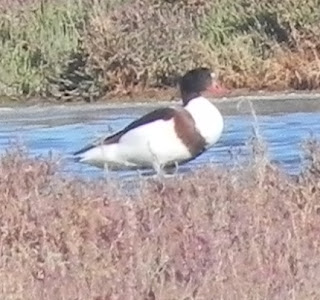There are newcomers as well as leavers. The newcomers are presumably more reluctant migrants than the previous waves. They may have finally been pushed here by much colder weather to the north.
Among them, I was pleased to see a dozen or so reed bunting at the water's edge in the short reeds.
reed bunting, Ain Azziana
This is a poorly recorded bird in Libya. The UN winter bird survey usually picks up 3 or 4 each year so I was pleased to see many more than this in one place.
Actually, Ain Azziana is accurately portrayed in the Collins guide map as a place to where you can see reed bunting in winter (but I didn't know this until I cross-checked afterwards).
The UN winter counts over the years have also seen a small number in scattered parts of Tripolitania. By contrast, these locations aren't on the Collins map.
another reed bunting, Ain Azziana
I had to be patient to photograph reed bunting. These birds didn't like to perch in the open like their corn bunting cousins. In fact I thought at one stage the picture of a flitting bird above was all I would get.
ain azziana
The water level at Ain Azziana has risen since my last visit so getting around was even more difficult than usual. So I only saw little white specks of a different bird in the distance with my binoculars at first. As I got a bit closer I found that a couple of common shelduck were near a group of black-winged stilt.
common shelduck with black-winged stilt
This is the first time I have seen common shelduck in Libya but they are well known to the UN winter count team. Once again the Collins guide does not have them in Libya on in its distribution map.
Talking of maps, over the past three months since I started writing this blog more regularly I have become more and more upset that the guides (I'm not picking out just one!) don't show Libya having about one third of the species it really has. My upset 's more of a sadness than an anger.
Libya has the longest Mediterranean coast line and really should merit more attention than that from the existing gallant band. I challenge the "experts" to come here and bird watch! It must be the best bet on the planet to find the slender-billed curlew for example (see my blog on curlews to follow in a few days ) but the coast is so long and the winter generates so many wetlands it needs larger numbers of observers.
close up of common shelduck at Ain Azziana
Let's look at another new arrival at Ain Azziana. I have seen bluethroat at other locations in Libya this winter (Brega and Jaghboub Oasis) but I hadn't seen any at Ain Azziana until this trip. However it has been a month since I last visited. In that time clearly they have arrived in considerable numbers.
bluethroats at Ain Azziana (left and right above)
There are more northern European males (red) than southern European males (white or none) as judged by the colour of the spots in their throats.
Incidentally bluethroat is on the guidebook maps as wintering in Morocco but not Libya. Let me assure you we've got plenty this winter!
meadow pipit, Ain Azziana
Each time I visit a wetland, I check the pipits to see how many are water pipit and how many are meadow pipit. All winter, at Ain Azziana they have been almost exclusively meadow pipit (at least in the areas I could access - maybe its different out in really flooded areas). By the way, only when I got home and processed my pictures did I realise the bird above only has got one leg.
starling, Ain Azziana
Finally I couldn't resist photographing these starling. They look like clothes pegs on a washing line.






















































